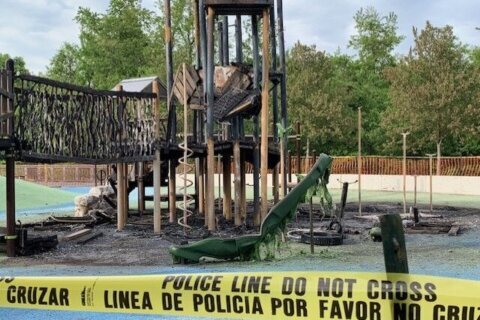Forensic genetic genealogy testing, a 20-year-old tip buried in police files and a discarded water bottle at Dulles International Airport culminated in a break in the cold-case killing of a Montgomery County, Maryland, woman, police say.
Eugene Gligor, 44, of D.C., made his first appearance Monday before a Montgomery County judge in the death of Leslie Preer, 50, who was found killed inside her Chevy Chase house in May 2001. Police arrested him last Tuesday.
He was held without bond and did not speak during the proceedings. His preliminary hearing is scheduled for July 19.
“The case remained open for 23 years,” Montgomery County State’s Attorney John McCarthy said outside the courthouse Monday, where he extolled the work of the Montgomery County police’s open cold case unit. “They did an extraordinary job … and I know that the family is very thankful for them remaining diligent to this.”
McCarthy said he will be seeking a charge of first-degree murder, which carries a maximum penalty of life imprisonment in Maryland.
Outside the courtroom Monday, Preer’s daughter — Lauren Preer, who had dated Gligor as a teenager — spoke briefly to reporters. She said she was shocked that someone her family had known for so long is now a suspect in her mother’s killing.
“Never in a million years would we think that one of our people could hurt my mom,” Lauren Preer said.
How police zeroed in on Gligor after 23 years
In 2022, with the case apparently at a dead end, investigators and prosecutors decided to take a swab of blood from the crime scene and send it off for what’s known as forensic genetic genealogy DNA analysis.
Forensic genealogy is a technique in which investigators use a known DNA sample to build a family tree of possible connections based on DNA profiles from publicly accessible genealogy websites.
That’s “what opened up the case,” McCarthy said.
The evidence was sent to Othram Inc. Labs in September 2022. A list of shared DNA matches was identified on the Family Tree DNA database — where the last name Gligor emerged, according to court documents.
That name also turned up in the original case file that dated back to January 2002. It was in a tip from one of Gligor’s neighbors who thought Lauren Preer’s boyfriend may have been related to the homicide.
By the time the DNA results came in, Gligor was living in Northwest D.C., police said.
But investigators still did not know whether Gligor was the suspect.
McCarthy said that while it’s “not definitive proof,” the use of genealogical DNA offers a clue.
“It’s a lead that allows us to decide in what direction to take this case,” he said.
Police put Gligor under surveillance.
That took them to Dulles Airport on June 9, where they saw him throw away a water bottle he drank from. Investigators collected the water bottle and tested it — it matched the DNA profile from the bloody crime scene, according to court documents.
Court documents also said that Gligor has never been arrested for any crimes in which his DNA would have been entered in the CODIS database, which holds DNA profiles from convicted offenders, unsolved crime scene evidence and missing persons.
What happened when Leslie Preer did not show up for work
The first sign of trouble at the house on Drummond Avenue in May 2001 came when Leslie Preer failed to show up for work.
Preer’s employer started calling members of her family, including her husband Carl and daughter Lauren.
Around 11:35 a.m., the employer and Carl Preer went to the house on Drummond Avenue in Chevy Chase, where they found a “suspicious scene,” court documents said.
There was blood spatter and smeared blood on the walls near the front door, dried blood on the corner by the front door, a puddle of water on the floor, a corner table that was knocked over, and a bloodstained rug that was in the foyer was moved into the living room.
Officers arrived to search the house and found Preer dead inside the upstairs master bathroom shower stall. There was evidence her killer tried to clean up the crime scene.
An autopsy found that in addition to the seven lacerations to her head, Preer was also strangled. Results also show that her head was “battered onto the foyer floor and the sharp edges of the shoe molding” surrounding the foyer and front-door area.
Get breaking news and daily headlines delivered to your email inbox by signing up here.
© 2024 WTOP. All Rights Reserved. This website is not intended for users located within the European Economic Area.








